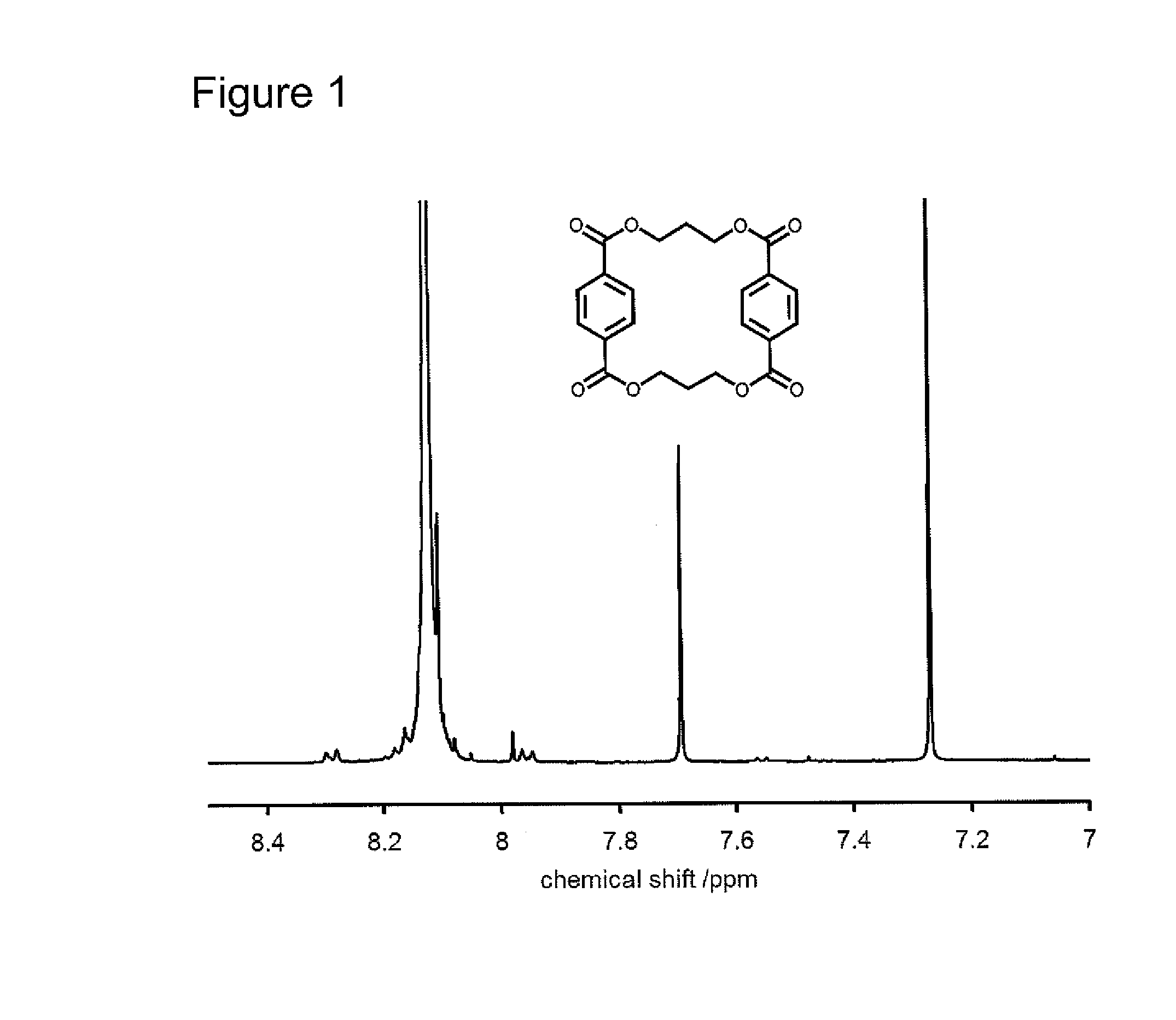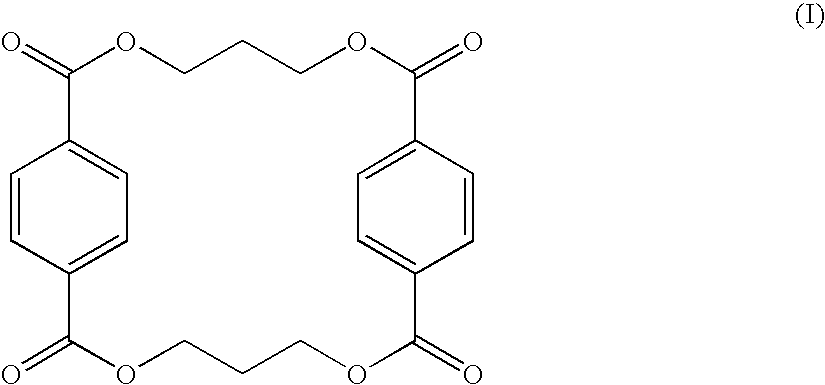Process of making a poly(trimethylene terephthalate) resin having low cyclic dimer content, and compositions and articles therefrom
- Summary
- Abstract
- Description
- Claims
- Application Information
AI Technical Summary
Benefits of technology
Problems solved by technology
Method used
Image
Examples
example 1
[0085]This example illustrates the process for solid phase polymerization of PTT.
[0086]Poly(trimethylene terephthalate) (PTT) resin (4680 Kg of pellets), provided from continuous polymerization of 1,3-propanediol with dimethyl terephthalate in the presence of titanium (IV) n-butoxide (100 ppm) having 33±2 mg per pellet with dimensions 2.9±0.2×2.8±0.2×4.1±0.2 mm, with an inherent viscosity of 0.76 dL / g, and with a PTT cyclic dimer concentration of 2.5 weight %, was charged to a dual cone tumble drier (ABBE rotating dryer, model 24, Patterson, N.J., USA) The tumble drier was rotated at a rate of 4 revolutions per minute while heating at a rate of 12° C. / h up to 205° C. under vacuum 0.65 mm Hg (86.66 Pa). The temperature of the drier was held at 207±2° C. for 10 hours. The dryer was cooled under vacuum until pellet temperature reached 60° C.; the vacuum was broken with nitrogen and the reactor was packed out under positive nitrogen pressure. The dryer was cooled at a rate of 22° C. / h t...
example 2
[0089]This example illustrates the process for solid phase polymerization of poly(trimethylene terephthalate).
[0090]PTT resin (11.3 Kg of pellets) provided from continuous polymerization of 1,3-propanediol with dimethyl terephthalate in the presence of titanium (IV) n-butoxide (100 ppm) having 38±1 mg per pellet with dimensions 2.9±0.2×2.8±0.2×4.1±0.2 mm, with an inherent viscosity of 0.76 dL / g, and with a PTT cyclic dimer concentration of 2.5 weight %, was charged to a dual cone tumble drier (#36 Conaform rotary dryer, Patterson Industries, Toccoa Ga. USA) The tumble drier was rotated at a rate of 6 revolutions per minute while heating at a rate of 36° C. / h up to 205° C. vacuum 1.8 mm Hg (240 Pa) and nitrogen 3.7 L / min. The temperature of the drier was held at 202±0.65° C. for 10 h. The dryer was cooled under vacuum until pellet temperature reached 60° C.; the vacuum was broken with nitrogen and the reactor was packed out under positive nitrogen pressure. The dryer was cooled at a ...
example 3
[0092]This example illustrates the process for compounding the solid phased poly(trimethylene terephthalate) pellets and testing of plaques.
[0093]PTT pellets from Example 1 were compounded using a twin screw extruder (Coperion ZSK58 SC, Ramsey, N.J., USA) using the following composition: 53 parts by wt solid phased PTT pellets, 0.30 parts zinc stearate, 0.20 parts Irganox® 1010, 0.20 parts Licowax® OP, 0.30 parts EPON 1009F, 45 parts PPG-3563 glass fiber, and 1.0 part RYNRE5334 BKC. The composition was extruded at a rate of 600 pounds per hour at a screw speed of 275 rpm and had a melt temperature of 323° C. to provide compounded pellets.
[0094]The compounded PTT pellets were molded into 76.2 mm×127 mm×3.175 mm plaques using a single screw injection molding machine (6 oz variable tonnage, HPM, Mount Gillian, Ohio, USA). The molding equipment was run at 150 tons. The melt temperature was 250° C. The mold temperature and cycle time of the plaques were 100° C. and 32 seconds respectfull...
PUM
| Property | Measurement | Unit |
|---|---|---|
| Temperature | aaaaa | aaaaa |
| Temperature | aaaaa | aaaaa |
| Mass | aaaaa | aaaaa |
Abstract
Description
Claims
Application Information
 Login to View More
Login to View More - R&D
- Intellectual Property
- Life Sciences
- Materials
- Tech Scout
- Unparalleled Data Quality
- Higher Quality Content
- 60% Fewer Hallucinations
Browse by: Latest US Patents, China's latest patents, Technical Efficacy Thesaurus, Application Domain, Technology Topic, Popular Technical Reports.
© 2025 PatSnap. All rights reserved.Legal|Privacy policy|Modern Slavery Act Transparency Statement|Sitemap|About US| Contact US: help@patsnap.com


